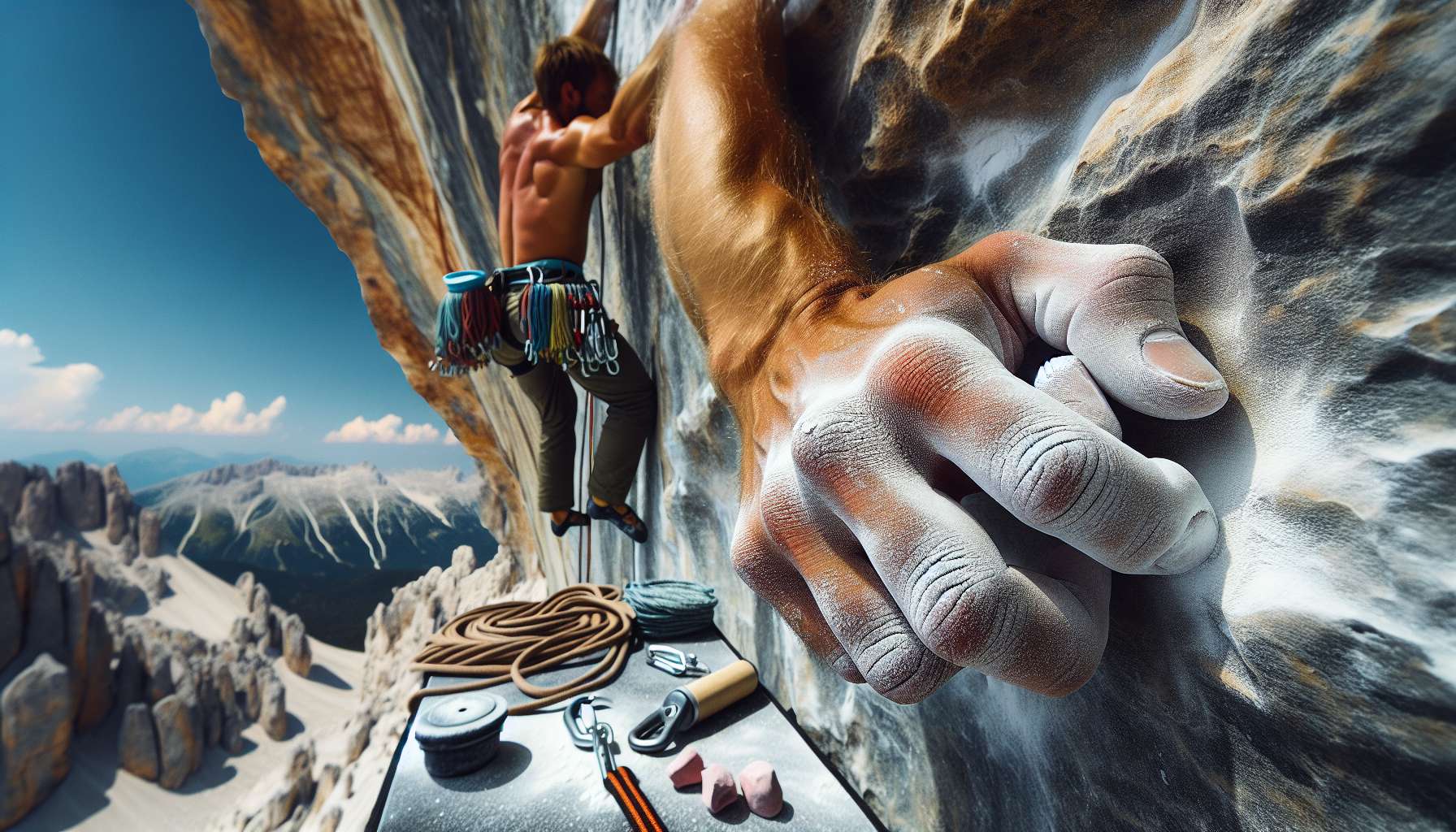The Ultimate Guide to Climbing Chalk: A Comprehensive Look
Introduction
When it comes to the world of climbing, one essential tool that often goes unnoticed is climbing chalk. This seemingly simple substance plays a crucial role in the success and safety of climbers, offering improved grip and reducing the risk of slipping. But what exactly is climbing chalk, and why is it so important in the world of climbing?
Imagine scaling a sheer rock face, relying solely on your hands and feet to navigate the treacherous terrain. In this high-stakes environment, every detail matters, including the type of chalk you choose to use. Climbing chalk is not just a tool; it is a lifeline for climbers, providing the extra grip needed to conquer challenging routes and push the limits of human potential.
In this comprehensive guide, we will delve deep into the world of climbing chalk, exploring its origins, composition, uses, and its impact on the climbing community. Join us on this journey as we uncover the secrets of this seemingly humble substance and discover why it is a vital companion for climbers around the world.
The History of Climbing Chalk
Although climbing chalk may seem like a modern invention, its use dates back centuries. In ancient times, climbers would often use a variety of substances, such as sand, ash, or even saliva, to improve their grip on rocky surfaces. However, it wasn’t until the 1950s that climbing chalk as we know it today was developed.
The advent of modern sport climbing in the mid-20th century brought about the need for a more effective and reliable grip-enhancing substance. Climbers experimented with various materials before settling on magnesium carbonate, the primary ingredient in climbing chalk. This white, powdery substance revolutionized the sport of climbing, providing climbers with a reliable way to keep their hands dry and increase friction on holds.
Since its introduction, climbing chalk has become a staple in every climber’s gear bag, with various forms and brands available on the market. From loose chalk to liquid chalk and everything in between, climbers have a plethora of options to choose from based on their preferences and climbing style.
The Composition of Climbing Chalk
One of the key components of climbing chalk is magnesium carbonate, a naturally occurring mineral that is commonly found in rock formations. This compound has excellent moisture-absorbing properties, making it an ideal choice for keeping hands dry and improving grip during climbing.
In addition to magnesium carbonate, climbing chalk may also contain other ingredients such as drying agents, pigments, or additives to enhance its effectiveness. Some climbers prefer chalk with added drying agents like silica or Epsom salt, which help absorb moisture more effectively and provide a longer-lasting grip.
It’s important to note that not all climbing chalk is created equal, and the quality of the chalk can vary depending on the brand and composition. Climbers often have their preferences when it comes to chalk, with some opting for softer, finer textures, while others prefer chunkier, more abrasive chalk for better friction on holds.
The Benefits of Climbing Chalk
So, why is climbing chalk such a crucial tool for climbers? The benefits of using climbing chalk are numerous, with each one contributing to a safer and more successful climbing experience. Here are some of the key advantages of using climbing chalk:
Improved Grip: Climbing chalk helps absorb moisture from the hands, reducing sweat and improving friction on holds. This increased grip allows climbers to make more precise movements and maintain control on difficult routes.
Reduced Risk of Injury: Sweaty hands can be a significant safety hazard while climbing, increasing the risk of slipping and falling. By using climbing chalk, climbers can minimize the risk of accidents and injuries, ensuring a safer climbing experience.
Enhanced Performance: With better grip and control, climbers can push their limits and attempt more challenging routes with confidence. Climbing chalk gives climbers the edge they need to perform at their best and achieve their goals.
Comfort and Confidence: Climbing chalk not only improves grip but also provides a sense of comfort and confidence to climbers. Knowing that their hands are dry and secure allows climbers to focus on their technique and enjoy the climbing experience to the fullest.
The Different Types of Climbing Chalk
As mentioned earlier, climbing chalk comes in various forms, each with its unique characteristics and benefits. Here are some of the most common types of climbing chalk available on the market:
Loose Chalk: Loose chalk is the most traditional form of climbing chalk, consisting of finely ground magnesium carbonate packaged in a resealable bag. Climbers can dip their hands into the bag to coat them with chalk before climbing, providing a quick and easy way to improve grip.
Chalk Balls: Chalk balls are a convenient alternative to loose chalk, offering a mess-free way to apply chalk to the hands. These porous balls are filled with chalk powder and can be squeezed to release a controlled amount of chalk onto the hands.
Liquid Chalk: Liquid chalk is a newer innovation in the world of climbing chalk, offering a more long-lasting grip compared to traditional chalk. This alcohol-based formula dries quickly on the hands, creating a thin layer of chalk that stays in place even during intense climbing sessions.
Block Chalk: Block chalk is a solid form of climbing chalk that can be broken into smaller pieces for easy application. This dense chalk provides a longer-lasting grip and is often favored by climbers who prefer a more robust texture.
Each type of climbing chalk has its advantages and drawbacks, depending on the climber’s preferences and climbing conditions. Some climbers may prefer the convenience of chalk balls, while others swear by the long-lasting grip of block chalk. Ultimately, the choice of chalk type comes down to personal preference and individual needs.
Expert Opinions on Climbing Chalk
We reached out to several renowned climbers and industry experts to gather their insights on the importance of climbing chalk in the world of climbing. Here’s what they had to say:
Emily Harrington, Professional Climber: “Climbing chalk is a game-changer for me. It gives me the confidence to push my limits and try new routes without worrying about slipping. I never leave for a climbing session without my trusty chalk bag.”
Dr. Alex Honnold, Climbing Scientist: “The science behind climbing chalk is fascinating. Its ability to absorb moisture and improve friction is crucial for climbers, especially when tackling difficult routes. Climbing chalk is a must-have for any serious climber.”
These expert opinions highlight the significance of climbing chalk in the climbing community and its role in enhancing performance and safety for climbers of all levels.
Common Misconceptions About Climbing Chalk
Despite its widespread use, climbing chalk is often misunderstood by non-climbers or beginners. Here are some common misconceptions about climbing chalk and the truth behind them:
Misconception: Climbing chalk is harmful to the environment.
Truth: While climbing chalk is a mineral-based substance, it is generally considered safe for the environment when used responsibly. Many climbing chalk brands offer environmentally friendly or sustainable options to minimize their impact on the natural world.
Misconception: Using climbing chalk is cheating or provides an unfair advantage.
Truth: Climbing chalk is a standard tool used by climbers to improve grip and safety while climbing. It is not considered cheating but rather a necessary accessory to enhance performance and prevent accidents.
By debunking these misconceptions, we can better understand the role of climbing chalk in climbing and appreciate its benefits without any undue stigma or misinformation.
FAQs About Climbing Chalk
Here are some common questions about climbing chalk and detailed answers to help clarify any doubts:
Q: Can I use regular gym chalk for climbing?
A: While gym chalk may be similar to climbing chalk, it is not specifically designed for climbing and may not provide the same level of grip and moisture absorption. It is recommended to use climbing-specific chalk for the best results.
Q: How often should I reapply climbing chalk during a climbing session?
A: The frequency of chalk application depends on personal preference and climbing conditions. Some climbers prefer to chalk up before each climb, while others may only reapply when necessary. Experiment with different approaches to find what works best for you.
Conclusion
In conclusion, climbing chalk is an indispensable tool for climbers of all levels, offering improved grip, safety, and performance on the rock. With its moisture-absorbing properties and friction-enhancing abilities, climbing chalk has revolutionized the sport of climbing and become a must-have essential for every climber’s gear bag.
As we’ve explored in this guide, climbing chalk comes in various forms, each with its unique benefits and characteristics. Whether you prefer loose chalk, chalk balls, liquid chalk, or block chalk, the choice of chalk type ultimately comes down to personal preference and climbing style.
Next time you hit the crag or climbing gym, don’t forget to pack your trusty chalk bag and make the most of this humble yet powerful substance. Climbing chalk may seem like a small detail, but its impact on your climbing performance and safety can be significant. So grab your chalk bag, dust up your hands, and conquer that next challenging route with confidence and ease!




